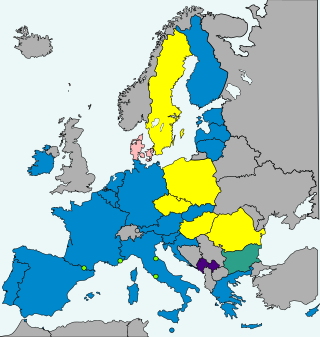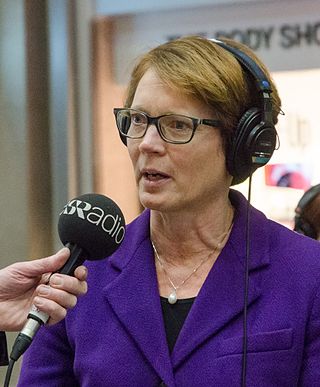Basel II is the second of the Basel Accords, which are recommendations on banking laws and regulations issued by the Basel Committee on Banking Supervision. It is now extended and partially superseded by Basel III.

Markets in Financial Instruments Directive 2014, commonly known as MiFID 2, is a legal act of the European Union (EU). Together with Regulation No 600/2014 it provides a legal framework for securities markets, investment intermediaries, in addition to trading venues. The directive provides harmonised regulation for investment services of the member states of the European Economic Area — the EU member states plus Iceland, Norway and Liechtenstein. Its main objectives are to increase competition and investor protection, as well as level the playing field for market participants in investment services. It repeals Directive 2004/39/EC.
The Lamfalussy process is an approach to the development of financial service industry regulations used by the European Union. Originally developed in March 2001, the process is named after the chair of the EU advisory committee that created it, Alexandre Lamfalussy. It is composed of four "levels", each focusing on a specific stage of the implementation of legislation.

Montenegro is a country in South-Eastern Europe, which is neither a member of the European Union (EU) nor the Eurozone; it does not have a formal monetary agreement with the EU either. However, it is one of the two territories that has unilaterally adopted the euro in 2002 as its de facto domestic currency. This means that even though the euro is not a legal tender there, it is treated as such by the government and the population.

The Capital Requirements Directives (CRD) for the financial services industry have introduced a supervisory framework in the European Union which reflects the Basel II and Basel III rules on capital measurement and capital standards.

The European Insurance and Occupational Pensions Authority (EIOPA) is a European Union financial regulatory agency. It was established in 2011 under EU Regulation 1094/2010.
The Committee of European Securities Regulators (CESR) was an independent committee of European Securities regulators, in place from 2001 to 2010. On 1 January 2011, it was replaced by the European Securities and Markets Authority (ESMA).

The economic and monetary union (EMU) of the European Union is a group of policies aimed at converging the economies of member states of the European Union at three stages.
The European System of Financial Supervision (ESFS) is the framework for financial supervision in the European Union that has been in operation since 2011. The system consists of the European Supervisory Authorities (ESAs), the European Systemic Risk Board, the Joint Committee of the European Supervisory Authorities, and the national supervisory authorities of EU member states. It was proposed by the European Commission in 2009 in response to the financial crisis of 2007–08.

The European Securities and Markets Authority (ESMA) is an agency of the European Union located in Paris.

The European Banking Authority (EBA) is a regulatory agency of the European Union headquartered in La Défense, Île-de-France. Its activities include conducting stress tests on European banks to increase transparency in the European financial system and identifying weaknesses in banks' capital structures.
A European Union-wide banking stress test exercise has been conducted by the Committee of European Banking Supervisors every year since 2009. The second instance was performed in July 2010. The Council of the European Union mandated that Committee so to do, in the aftermath of the global financial crisis which started in 2007.

Andrea Enria an Italian economist who currently serves as Chair of the ECB Supervisory Board, as of 1 January 2019. He previously served as the chairperson of the European Banking Authority (EBA) between 2011 and 2019.

European Banking Supervision, also known as the Single Supervisory Mechanism (SSM), is the policy framework for the prudential supervision of banks in the euro area. It is centered on the European Central Bank (ECB), whose supervisory arm is referred to as ECB Banking Supervision. EU member states outside of the euro area can also participate on a voluntary basis, as was the case of Bulgaria as of late 2023. European Banking Supervision was established by Regulation 1024/2013 of the Council, also known as the SSM Regulation, which also created its central decision-making body, the ECB Supervisory Board.
Hungarian Development Bank Private Limited Company or Hungarian Development Bank, in short, is a credit institution fully owned by the government of Hungary.
The banking union refers to the transfer of responsibility for banking policy from the national to the European Union (EU) level in several EU member states, initiated in 2012 as a response to the Eurozone crisis. The motivation for banking union was the fragility of numerous banks in the Eurozone, and the identification of a vicious circle between credit conditions for these banks and the sovereign credit of their respective home countries. In several countries, private debts arising from a property bubble were transferred to the respective sovereign as a result of banking system bailouts and government responses to slowing economies post-bubble. Conversely, weakness in sovereign credit resulted in deterioration of the balance sheet position of the banking sector, not least because of high domestic sovereign exposures of the banks.

The Capital Requirements Regulation(EU) No. 575/2013 is an EU law that aims to decrease the likelihood that banks go insolvent. With the Credit Institutions Directive 2013 the Capital Requirements Regulation 2013 reflects Basel III rules on capital measurement and capital standards.

The Capital Markets Union (CMU) is an economic policy initiative launched by the former president of the European Commission, Jean-Claude Juncker in the initial exposition of his policy agenda on 15 July 2014. The main target was to create a single market for capital in the whole territory of the EU by the end of 2019. The reasoning behind the idea was to address the issue that corporate finance relies on debt (i.e. bank loans) and the fact that capital markets in Europe were not sufficiently integrated so as to protect the EU and especially the Eurozone from future crisis. The Five Presidents Report of June 2015 proposed the CMU in order to complement the Banking union of the European Union and eventually finish the Economic and Monetary Union (EMU) project. The CMU is supposed to attract 2000 billion dollars more on the European capital markets, on the long-term.

Kerstin Margareta af Jochnick is a Swedish banker and economist. She is currently serving as a member of the ECB Supervisory Board, and was the former First Deputy Governor of the Sveriges Riksbank, the central bank of Sweden.








